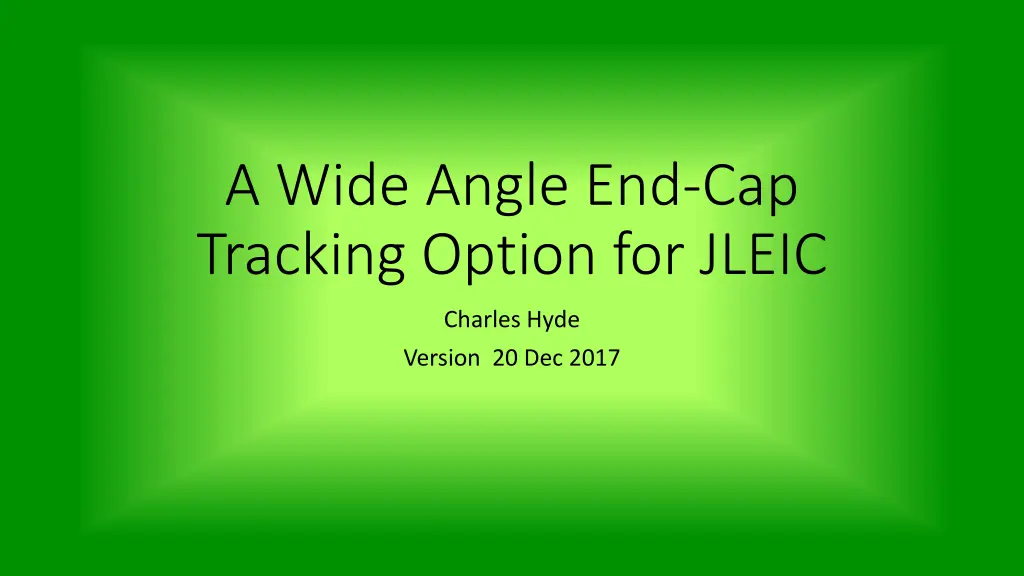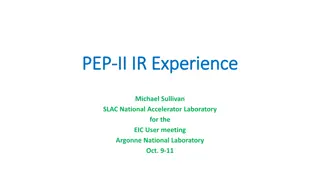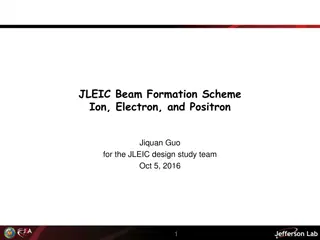
Advanced End-Cap Tracking Options for JLEIC Facility
Explore the innovative end-cap tracking solutions for the JLEIC facility, including detailed insights on the philosophy behind tracking mechanisms, challenges in electron beam shielding, modular design of central detectors, and the implementation of advanced RICH technologies. Dive into the intricacies of dual-RICH design guidelines and the significance of efficient fringe field management for optimal performance.
Download Presentation

Please find below an Image/Link to download the presentation.
The content on the website is provided AS IS for your information and personal use only. It may not be sold, licensed, or shared on other websites without obtaining consent from the author. If you encounter any issues during the download, it is possible that the publisher has removed the file from their server.
You are allowed to download the files provided on this website for personal or commercial use, subject to the condition that they are used lawfully. All files are the property of their respective owners.
The content on the website is provided AS IS for your information and personal use only. It may not be sold, licensed, or shared on other websites without obtaining consent from the author.
E N D
Presentation Transcript
A Wide Angle End-Cap Tracking Option for JLEIC Charles Hyde Version 20 Dec 2017
JLEIC: What is our philosophy? Initially, tracking near Solenoid Axis over azimuthal symmetry around ion beam axis. Large forward Dipole : B dl = 2 Tm Acceptance 90 mrad (later shrunk to 66 mrad?) Centered on electron beam Can be offset (dashed line) centered on ion beam. Requires active + passive superconducting shielding of electron beam. Minimal impact on DualRICH Dual RICH 2/28/18 JLEIC-Detector-C.Hyde 2
EIC Central detector/ magnets JLEIC Standard p-FQs Forward Dipole Acceptance 35 mrad around Ion beam 2 Tm Modest challenge for electron beam shielding Very poor tracking for tracks near Solenoid Axis e-FFQs IP p- FFQs e-FQs 2/28/18 JLEIC-Detector-C.Hyde 3 Modular design of the central detector 17 Yulia Furletova
Large Aperture (15) Quad before dRICH 2/28/18 JLEIC-Detector-C.Hyde 4
10 Aperture Dipole (2 Tm) before dRICH Shorten Dipole to 1 m Add gas threshold Cherenkov at 10-20 (Kaon-Blind Detector) 2/28/18 JLEIC-Detector-C.Hyde 5
Guidelines for design dual-RICH needed for <15 ( >2) Partial coverage for 4< Ion<5 mRICH in front of Quad coils ?/K/p PID up to 10 GeV/c A PID solution for the EIC - implementation Ion Beam-Line requires 2Tm @ 100GeV/c Quad 2.85 z 4.35 Field is transverse Oscillates from azimuthal to radial Gradient = 7.4 T/m 8.6 T Peak Pole field (z=4.35, r0=1.17 m) Fringe fields ~1/(r0+ z)3 Alternate is 1.33 T Dipole Dipole requires stronger shielding on electron beamline Fringe fields ~1/(r02 + z2) provides a compact and cost- effective way to cover the area. pi/K/p separation up to ~6-7 GeV/c JLEIC-Detector-C.Hyde e p/A h-endcap h-endcap: A RICH with two radiators (gas + aerogel) is needed for pi/K/p separation up to ~50 GeV/c 10x100 GeV Q2> 1 GeV2 GeV barrel Far-Foward e-endcap e-endcap: A compact aerogel RICH which can be projective pi/K/p separation up to ~10 GeV/c Dual- RICH Aerogel-RICH barrel: A high-performance DIRC DIRC Aerogel RICH rapidity 2/28/18 6 10 = 2.4 TOF (and/or dE/dx in TPC): can cover lower momenta. Photosensors and electronics: need to match the requirements of the new generation devices being developed both for the final system and during the R&D phase 6
Problems Dual-RICH is in fringe field of Quad/Dipole Quad field is stronger than Solenoid! Quad/Dipole must be as close to IP as electron-beam shielding will allow Space for dRICH, TRD (not included in drawing), Crystal EMCal in from of first ion FFQ. Quad is technically challenging Easier to work with electron beam-line Dipole fringe field on electron beam near IP (|z|<2.5 m) Very hard to shield Field clamp? 2/28/18 JLEIC-Detector-C.Hyde 7
Electron Beam-Line Magnetic Shielding: Quadrupole Option Gradients of Electron Upstream FFQ (1,2,3)= ( 21.95, +22.76, 8.18) T/m Positive is focusing in x for e Detector Quad 7.4 T/m (defocusing for p & e in opposite directions If pure electron beam quads (no iron) Simply adjust electron quad strengths to compensate: e FFQ = ( 14.55, +30.16, 0.78) T/m e+FFQ = (+29.35, 15.36, +15.58) T/m Quad field outside e-quads at centerplane of each: 2/28/18 JLEIC-Detector-C.Hyde 8
PID Requirements Shrink Forward Magnet to 10 15 < <20 : pi/K/p up to 10 GeV/c: 10 < <15 : pi/K/p up to 20 GeV/c: (Threshold Cherenkov with n=1.003 mRICH?) 6 < <10 : pi/K/p up to 30 GeV/c: Gas RICH Lighthousing OK for solenoidal field with 0.75 Tm or Dipole 0.1 Tm 2.0 > > 1.7 2.4 > > 2.0 3.0 > > 2.4 2/28/18 JLEIC-Detector-C.Hyde 9
Conclusions (personal) Azimuthal Symmetry broken by Crossing Angle Two IP Strategy favors two basic options: Detector based on excellent tracking Detector based on uniform and hermetic Hcal Large (> 5 deg) forward dipole puts almost impossible challenges on electron beam line and Gas RICH Requirements for high-x physics not yet articulated High-x physics favors modest energy maximal luminosity 4 x 50 or 4 x 100 GeV2 running. 4 Large Dipole at 6 m with strong shield on electron beam still looks viable Focus on General Purpose Detector(s) up to CD1 2/28/18 JLEIC-Detector-C.Hyde 10



